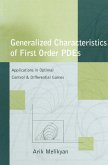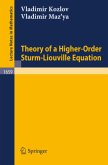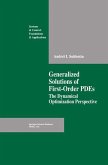In some domains of mechanics, physics and control theory boundary value problems arise for nonlinear first order PDEs. A well-known classical result states a sufficiency condition for local existence and uniqueness of twice differentiable solution. This result is based on the method of characteristics (MC). Very often, and as a rule in control theory, the continuous nonsmooth (non-differentiable) functions have to be treated as a solutions to the PDE. At the points of smoothness such solutions satisfy the equation in classical sense. But if a function satisfies this condition only, with no requirements at the points of nonsmoothness, the PDE may have nonunique solutions. The uniqueness takes place if an appropriate matching principle for smooth solution branches defined in neighboring domains is applied or, in other words, the notion of generalized solution is considered. In each field an appropriate matching principle are used. In Optimal Control and Differential Games this principle is the optimality of the cost function. In physics and mechanics certain laws must be fulfilled for correct matching. A purely mathematical approach also can be used, when the generalized solution is introduced to obtain the existence and uniqueness of the solution, without being aimed to describe (to model) some particular physical phenomenon. Some formulations of the generalized solution may meet the modelling of a given phenomenon, the others may not.








